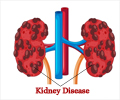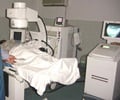As the holidays approached last year, Soraya Kohanzadeh, 30, Muir Beach, CA, was living day to day, extremely ill, with no hope and expecting to live a shortened life dependent on kidney dialysis.
As the holidays approached last year, Soraya Kohanzadeh, 30, Muir Beach, CA, was living day to day, extremely ill, with no hope and expecting to live a shortened life dependent on kidney dialysis. She needed a kidney transplant but because her “anti-donor” antibody levels were so high, her doctors believed that a transplant was not possible – perhaps ever. However, thanks to a specialized type of anti-rejection therapy pioneered at Cedars-Sinai Medical Center, Soraya successfully underwent a transplant in May of this year and has a “new lease on life” as she looks forward to 2007.
Soraya, was among the estimated 33 percent of kidney failure patients who have high “anti-donor” antibody levels and who are often told that a transplant is not possible even if a potential donor’s tissue and blood types otherwise match perfectly.But on May 16, 2006, she received a kidney donated by her mother, Joan Lando, at Cedars-Sinai . The transplanted kidney started working immediately, both patients recovered well, and Soraya has had no episodes of rejection – the result of a therapy that makes the incompatible compatible and the impossible a reality in many cases.
Soraya had expected to live a shortened life, dependent on kidney dialysis -- a painful, expensive, time-consuming procedure that cleans blood well enough to maintain existence but not well enough to contribute to quality of life.
Physicians in the San Francisco area said transplantation was not an option because a donor organ would be rejected by her hyper-vigilant immune system – a prospect faced by about one-third of the more than 70,000 patients on the nation’s kidney transplant waiting lists. But Soraya conducted an Internet search and found that Cedars-Sinai is one of the very few centers in the nation addressing this problem.
Tissue compatibility issues exist for all patients receiving transplanted organs, but rejection risks are dramatically increased for those with high exposure to “non-self” human leukocyte antigens (HLAs). Exposure may come through blood transfusions, previous transplantation or even pregnancy, when the mother is exposed to the father’s antigens, which are expressed in the cells of the developing baby. The immune system is then “sensitized” to those antigens – primed with antibodies to attack, even if the antigens arrive in the form of a potentially life-saving donated organ.
Stanley C. Jordan, M.D., medical director of Renal Transplantation and Transplant Immunology at Cedars-Sinai’s Center for Liver and Kidney Diseases and Transplantation, pioneered in the late 1980s the use of intravenous immunoglobulin (IVIG) as a way to reduce organ rejection among highly sensitized individuals. After undergoing years of experiments and clinical trials, IVIG became a fully accepted, Medicare-approved therapy in 2004 when it was found effective in a multi-center study partly funded by the National Institutes of Health.
Soraya says it may have been three or four months from the time she learned about IVIG and called Cedars-Sinai to the day of the operation. During that time her mother underwent many tests to make sure that she was as able a donor as she was willing.
Soraya’s kidneys were healthy until March 2003 when she underwent surgery for a congenital heart defect and a major vein was accidentally severed. The 24 units of blood she was given over the next few hours saved her life, but her kidneys suffered irreparable damage, and along with all those transfusions of other people’s blood came high exposure to non-self HLAs.
Jordan estimates that about 40 percent of Cedars-Sinai’s kidney transplant patients are in the highly sensitized category, referred to the program – or self-referred – because they could not be considered for transplantation elsewhere. “We’re able to transplant probably about 95 to 97 percent of the patients we see,” he adds.
Joan’s donor operation was performed by Gerhard Fuchs, M.D., director of Cedars-Sinai’s Minimally Invasive Urology Institute. He is one of the few surgeons who specialize in laparoscopic donor nephrectomy, which requires only a few small incisions to remove a kidney for transplantation. Minutes after Joan’s kidney was removed, a team headed by J. Louis Cohen, M.D., began the process of placing it into Soraya’s abdominal cavity and connecting it to her urinary system. Cohen is surgical director of Kidney Transplantation and medical director of Operating Room Services.
“This time last year, Soraya was living day to day, extremely ill and with no hope. Now she is back to herself – healthy, cheerful and energetic,” says Joan, 58. “And this is someone who was told that she was so highly sensitized that she could never get a kidney. We should have been totally hopeless, but somehow – I don’t know how – we kept thinking there has to be somebody doing something somewhere. And as it turned out, it was just in L.A. It’s over for us, but to think that there are other people, just like us, sitting in clinics, who don’t even have a clue.”
Soraya, who used to teach high school algebra, has been able to go back to work as a volunteer teacher at Marin County’s Juvenile Hall in San Rafael.
“Somewhere between 25 to 30 percent of patients on the kidney transplant list could benefit from this therapy to help them get transplanted,” says Jordan. “Patients who are on dialysis and those who are progressing toward renal failure need to know that they have a right to be considered for a kidney transplant. Their doctor should refer them to a transplant center even before they start dialysis so that they can be evaluated and the best treatment options can be determined for them. Patients who have a living donor do not need to be on dialysis before being transplanted, and the data show that if patients get transplanted before they start dialysis, they actually do better.”
One of seven hospitals in California whose nurses have been honored with the prestigious Magnet designation, Cedars-Sinai Medical Center is one of the largest nonprofit academic medical centers in the Western United States. For 18 consecutive years, it has been named Los Angeles’ most preferred hospital for all health needs in an independent survey of area residents. Cedars-Sinai is internationally renowned for its diagnostic and treatment capabilities and its broad spectrum of programs and services, as well as breakthroughs in biomedical research and superlative medical education. It ranks among the top 10 non-university hospitals in the nation for its research activities and is fully accredited by the Association for the Accreditation of Human Research Protection Programs, Inc. (AAHRPP).
Source-Newswise
SRM











